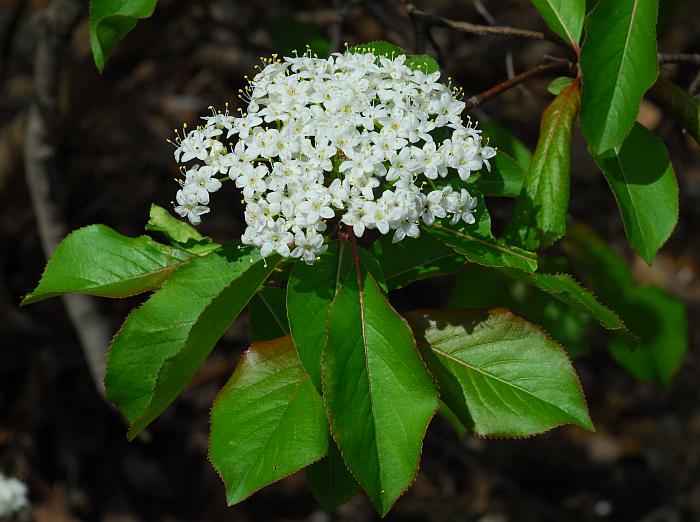Viburnum rufidulum Raf.
Southern Blackhaw

Native
CC = 4
CW = 5
MOC = 81
© SRTurner
Viburnum rufidulum Raf.Southern Blackhaw | |
 |
Native CC = 4 CW = 5 MOC = 81 |
© SRTurner |
|
Family - Caprifoliaceae Habit - Shrub or small tree to 6 m tall. Stems - Bark firm, not peeling, relatively smooth to finely roughened or warty on younger branches, occasionally forming small plates or furrows on older trunks, gray to grayish brown or purplish gray. Winter buds oblong-conical, often somewhat flattened, with a pair of scales, these with margins touching but not overlapping, densely pubescent with minute, red to reddish brown, stellate hairs, not sticky.
Leaves - Opposite, simple, petiolate. Petioles 7-16 mm long, with poorly to moderately well-developed wings 0.2-1.0 mm wide flanking the ventral groove, especially toward the tip, these straight, densely pubescent with microscopic, red to reddish brown, stellate hairs, sometimes appearing less pubescent late in the season, lacking prominent glandular swellings near the tip. Leaf blades 1.5-10.0 cm long, 1.0-6.5 cm wide, unlobed, relatively thick and somewhat leathery, elliptic to oblong-ovate, rounded to angled or occasionally short-tapered at the base, rounded or broadly angled to a usually bluntly pointed tip, the margins finely toothed with the teeth 5-11 per cm, the upper surface glabrous or with scattered microscopic, reddish, stellate hairs mostly along the midvein, shiny, the undersurface moderately to densely pubescent with scattered microscopic, reddish, stellate hairs when young, these becoming more scattered and mostly along the main veins with age, pinnately veined, the secondary veins evenly spaced, curved or arched toward the tip, looping and joined with adjacent veins into a network, not reaching the margin.
Inflorescences - Dense, flat-topped panicles, terminal on branches, sessile or short-stalked, with 3-5 primary branches, these sparsely pubescent with scattered microscopic, red to reddish brown, stellate hairs, usually also with scattered longer, branched or tangled hairs, at least when young, the marginal flowers fertile and similar to the other flowers.
Flowers - Calyx lobes 0.3-3.0 mm long, variously shaped. Corollas 2-4 mm long, actinomorphic, more or less saucer-shaped or rarely somewhat bell-shaped with a broadly cup-shaped tube 1-2 mm long and a spreading, 5-lobed portion 3-8 mm in diameter (measured across the top of the flower), the lobes rounded, white, sometimes fading to pale yellow. Style absent or nearly so, the ovary often broadly conical-tapered at the tip, the deeply 3-lobed stigma appearing sessile.
Fruits - Berrylike drupes 8-18 mm long, ellipsoid, oblong-ovoid, or nearly spherical, bluish purple to blue or bluish black, glaucous. Nutlet 7-15 mm long, yellowish brown to dark brown.
Flowering - April - May. Habitat - Bottomland forests, upland forests, streambanks, glade margins, bluffs, fencerows, pastures, railroads, and roadsides. Origin - Native to the U.S. Lookalikes - Other species of Viburnum, especially V. prunifolium. Other info. - This attractive shrub or small tree is common in the southern and eastern 2/3 of Missouri. Outside of Missouri its range encompasses the southeastern quadrant of the continental U.S. The showy inflorescences make the plant fairly easy to identify when it is in bloom, although it can closely resemble its lookalikes. V. rufidulum is distinguished by having a normally dense covering of minute, reddish, woolly hairs on the leaf petioles, an also by the shiny upper surface and somewhat thick and leathery texture of the leaves. Photographs taken at Whetstone Creek Conservation Area, Callaway County, MO., 2-19-04 and 5-4-04 (DETenaglia); also at Cuivre River State Park, Lincoln County, MO, 5-09-2011; Marble Creek campground, Madison County, MO, 4-13-2017; along the Katy Trail near Treloar, Warren County, MO, 7-16-2020; and at Little Lost Creek Conservation Area, Warren County, MO, 6-27-2023(SRTurner). |